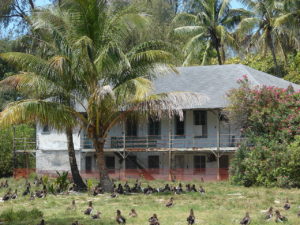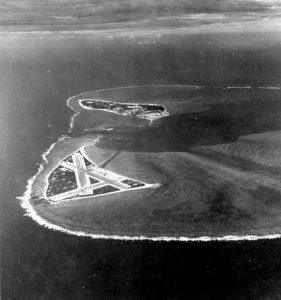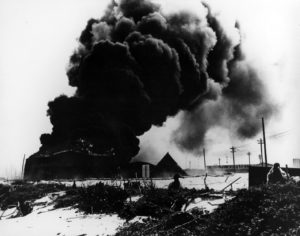
These workers introduced many non-native species to the island, including the canary, cycad, Norfolk Island pine, she-oak, coconut, and various deciduous trees; along with ants, cockroaches, termites, centipedes, and countless others.
On January 20, 1903, the United States Navy opened a radio station in response to complaints from cable company workers about Japanese squatters and poachers. Between 1904 and 1908, President Roosevelt stationed 21 Marines on the island to end wanton destruction of bird life and keep Midway safe as a U.S. possession, protecting the cable station.
In 1935, operations began for the Martin M-130 flying boats operated by Pan American Airlines.

The M-130s island-hopped from San Francisco to China, providing the fastest and most luxurious route to the Far East and bringing tourists to Midway until 1941. Only the very wealthy could afford the trip, which in the 1930s cost more than three times the annual salary of an average American. With Midway on the route between Honolulu and Wake Island, the flying boats landed in the atoll and pulled up to a float offshore in the lagoon. Tourists transferred to a small powerboat that ferried them to a pier, then rode in “woodie” wagons to the Pan Am Hotel or the “Gooneyville Lodge”, named after the ubiquitous “Gooney birds” (albatrosses).
World War II:
The location of Midway in the Pacific became important militarily. Midway was a convenient refueling stop on transpacific flights, and was also an important stop for Navy ships. Beginning in 1940, as tensions with the Japanese rose, Midway was deemed second only to Pearl Harbor in importance to the protection of the U.S. west coast. Airstrips, gun emplacements and a seaplane base quickly materialized on the tiny atoll.
The channel was widened, and Naval Air Station Midway was completed. Midway was also an important submarine base.
On February 14, 1941, President Franklin Roosevelt issued Executive Order 8682 to create naval defense areas in the central Pacific territories.

The proclamation established “Midway Island Naval Defensive Sea Area”, which encompassed the territorial waters between the extreme high-water marks and the three-mile marine boundaries surrounding Midway. “Midway Island Naval Airspace Reservation” was also established to restrict access to the airspace over the naval defense sea area. Only U.S. government ships and aircraft were permitted to enter the naval defense areas at Midway Atoll unless authorized by the Secretary of the Navy.
Midway’s importance to the U.S. was brought into focus on December 7, 1941 when the Japanese attacked Pearl Harbor. Midway was attacked by two destroyers on the same day, and the Japanese force was successfully repulsed in the first American victory of the war. A Japanese submarine bombarded Midway on February 10, 1942.
Four months later, on June 4, 1942, a major naval battle near Midway resulted in the U.S. Navy inflicting a devastating defeat on the Japanese Navy.
